Day Trips from Paris: Champagne Country, Artist Villages and More
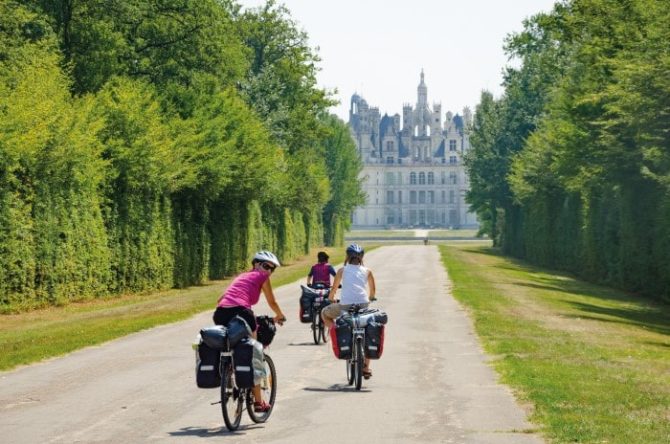

Just a stone’s throw from the City of Light, you will find fine art, world-class food and historic buildings to rival the capital itself – plus more besides, says Chloe Govan.
Strolling through the palatial grounds of the Château de Cheverny, I spot a group of snoozing dogs, languidly lazing in their kennels – or so it seems. I approach, extending my hand in greeting, only for half a dozen of the château’s 120-strong pack of hounds to throw themselves with full force against the netting of their enclosure, barking with enough boisterous enthusiasm to wake the dead. Then my eyes dart to a sign that was previously above my line of vision “Prière de Ne Pas Exciter Les Chiens”. Perhaps, then, it is better to let sleeping dogs lie…
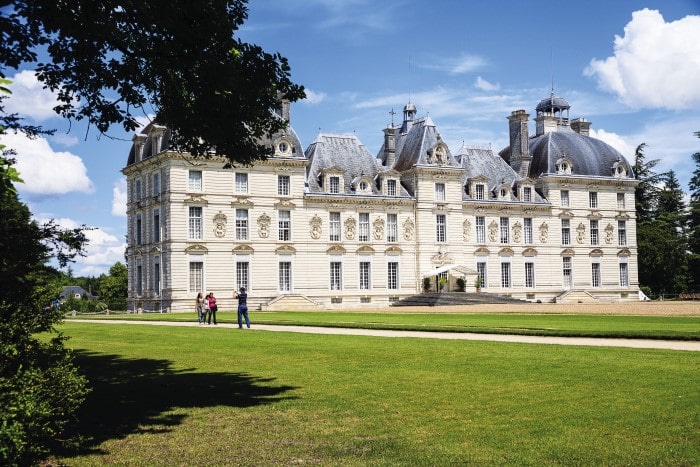
The Château de Cheverny © Shutterstock
Châteaux Galore
Yet while the resident hunting hounds might return to their slumbers, there’ll be no snoozing for me on an action-packed itinerary through the very best of the Loire Valley’s châteaux. All within easy commuting distance of Paris, visiting the big names is well worth the effort. Last year, Cheverny hosted a Lego-style recreation of the most expensive work of art in the world – the €382m ‘Salvator Mundi’ – plus a miniature Lego version of itself which used 216,122 bricks and took over 700 hours to build! There are numerous other exhibitions planned for the château, which also hosts a permanent Tintin building dedicated to the cartoon detective and Hergé, the author who created him. Tintin’s fictional home, Marlinspike Hall, was inspired by none other than Château de Cheverny, as seen in the books’ illustrations.
Then there’s Château de Chaumont, the castle that allegedly inspired the one seen in the recent Cinderella movie and which today blends ancient interiors with modern artwork. Another unmissable one for any itinerary is Château de Chenonceau, a lakeside beauty with gleaming white marble structures that look stunning from the skies during a hot air balloon ride. Perhaps most famous of all is Chambord, a 440-room palace and former hunting lodge surrounded by swathes of forest. Days spent here, cycling and walking around the vast grounds, are idyllic – and the medieval re-enactment scenes brought to life by horseback actors represent first-class entertainment. Expect to see trained birds pretending to peck a fallen soldier to death, while acrobatic stunts see the actors deliberately hurtling off horses before hoisting themselves back up again.
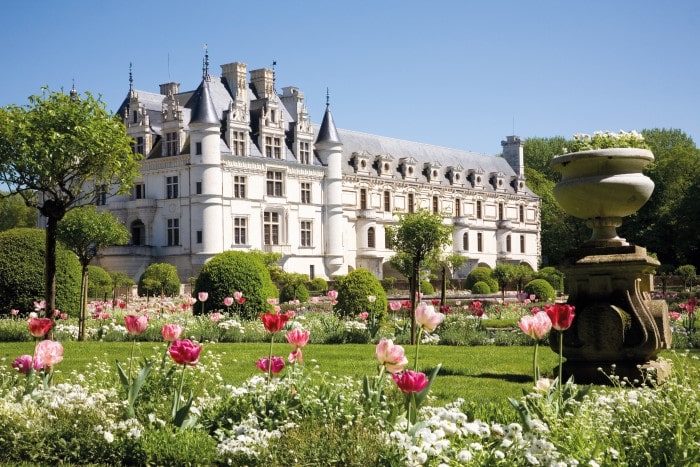
The spectacular grounds at the Château Chenonceau © Shutterstock
Aside from the Loire, Versailles is a must-see on the château circuit too, barely requiring an introduction. This year has seen the opening of a luxurious new hotel by Airelles, Le Grand Contrôle, which means guests can now sleep in the grounds of the palace – where Marie Antoinette celebrated her wedding – for the first time in centuries.
Historic Fontevraud
These buildings are the ultimate in grandeur, but it’s not all about palatial luxury, of course. Besides its château, where self-confessed evil queen Catherine de’ Medici died, Blois hosts an intriguing museum dedicated to magic, which holds regular performances guaranteed to raise a smile. Then there are the more modest châteaux, such as Clos Lucé, gifted to Leonardo da Vinci after he travelled over the Alps to France on the invitation of the art-addicted King Francis I. Visitors can see his bedroom and full-size replicas of some of his most outrageous inventions. There’s a bird-like flying machine and even a military armoured tank surrounded on all sides by guns, which he predicted would “take the place of the elephants” and, with bellows inside, would “spread terror among the enemy’s horses”. Such violent inventions created by someone from Italy – then an enemy country to France – perhaps ought to have caused alarm, but the king seemed remarkably unfazed.
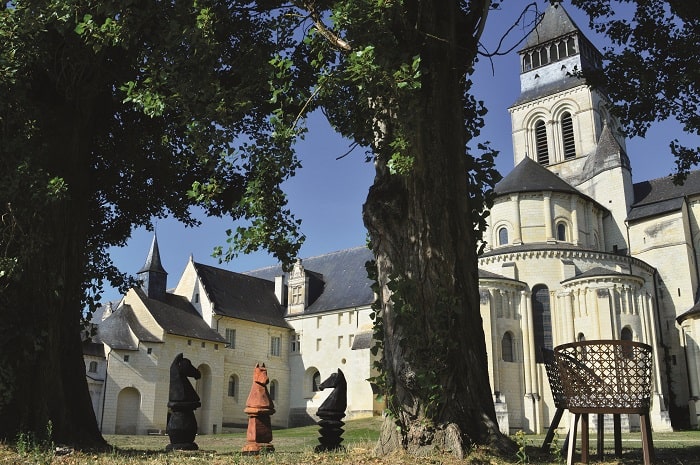
Fontevraud Abbey has a dark past © Chloe Govan
Meanwhile, in stark contrast to the luxury that attracts many visitors to the Loire, Fontevraud Abbey is a lesson in grave austerity. Wishing to isolate themselves totally from the unbelieving outside world, the nuns here grew their own food, used their own watermills and practised total self-sufficiency. However they were also renowned for their heartbreaking cruelty, slave labour and torture techniques unleashed on captives of war in their prison. Literary great Jean Genet was imprisoned here and much despised for his homosexuality. It is here you can see the tombs of Eleanor of Aquitaine and Richard the Lionheart.
Now to another moment in history. Most know about Van Gogh’s absinthe-fuelled escapades, slicing off his own ear after a fight with Gauguin in Arles, and many also know about his attempts to heal at a mental health centre in Saint-Rémy-de Provence. Yet a lesser told story is the one of his torturous final days in the peaceful artist village of Auvers-sur-Oise. Back then a quiet countryside idyll, in spite of its close proximity to the capital, it offered views of sunflowers, poppies and fields of wheat stretching as far as the eye could see, plus orchards, meadows, vineyards and stunning riverside scenes. It had become an Impressionist painters’ paradise and was already home to Daubigny, Cézanne and Pissarro when, on that fated day in 1890, Van Gogh arrived from Paris on the train.
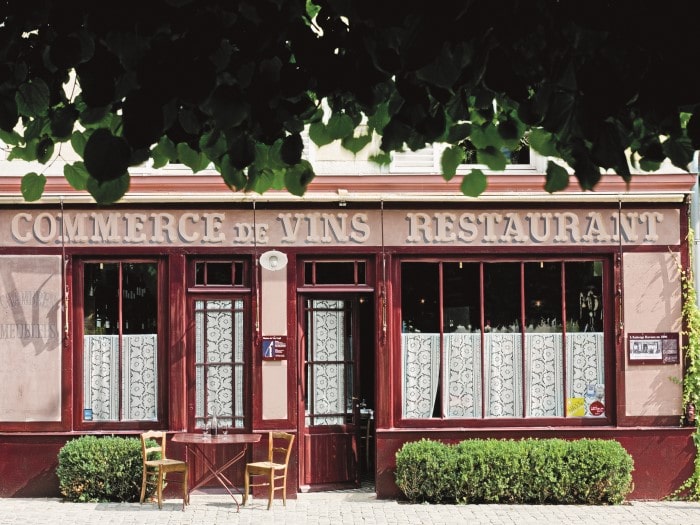
Auberge Ravoux, a favourite haunt of Vincent Van Gogh, and where you can still eat at his table © Erik Hesmerg
Van Gogh’s Last Days
As soon as he descended from the platform and emerged into this mini Montmartre, he made a beeline for the Auberge Ravoux, a restaurant and inn run by the rowdy Arthur Ravoux. A keen bartender, he would allegedly “fly into a rage if anyone contradicted him”, which happened quite often during his animated tales of the Franco-Prussian war. It might not have been the best place for someone as dogged by temptation as Van Gogh, as the bar kept an ample stock of absinthe available to clients. However, with rates of just a single franc per day to rent a room – two and a half times less than the added cost of dinner in the restaurant downstairs – it was little wonder he was tempted to call the auberge his temporary new home.
Pissarro had recommended a mental health doctor in the area for him, while his brother Theo was just half an hour away in Paris. Vincent, who by the age of 37 had racked up more residential addresses than years of his life, immediately fell in love with the village’s rural beauty and declared it his favourite, painting nearly 80 canvases there in just 70 days.
His artwork is now legendary, but at the time he was neither widely appreciated nor understood and his passion for nature was ultimately not enough to stave off his mental health struggles. During a moment of intense despair, he shot himself in the chest while walking down a quiet country lane. Yet his suicide bid failed and he was forced to drag himself, groaning in agony, back to his room at the Auberge Ravoux. Naturally his concerned landlord alerted the gendarmerie – and his beloved brother, Theo.
Weeping at his bedside, Theo expressed his desire to get him better but a heavily bleeding Vincent merely declared, “La tristesse durera toujours” – or, in English, “The sadness will last forever”. Two days later, his suffering ended in death.
Although life’s agonies ultimately got the better of him, he was at least laid to rest in his favourite place. Art enthusiasts are likely to appreciate the village’s beauty as much as he did, and today can embark on an Impressionist art trail that follows in the tortured artist’s footsteps, a journey through 22 of the sights that inspired his paintings. The local tourist office can provide a map and details of the walk.
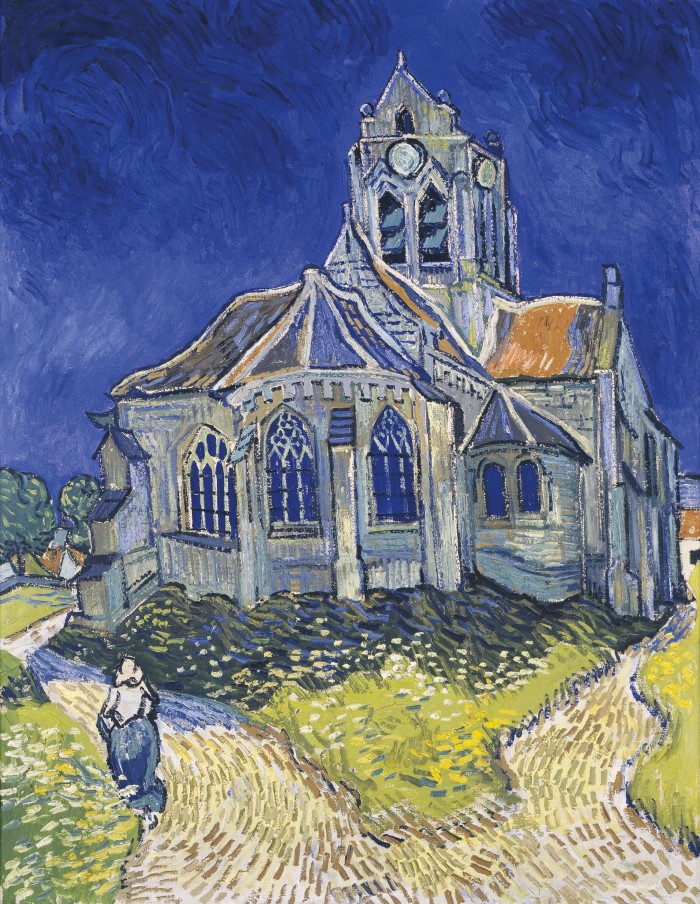
Van Gogh’s rendering of the church, where the priest later refused to hold his funeral, in Auvers sur Oise
One of the most legendary locations on the stroll is the local church, which brought its fair share of injustice to the Van Gogh family. He’d loved the church so much he’d painted it, finding comfort in replicating its imposing architectural structure. But after his death, the unforgiving local priest refused to host his funeral there, not just because he was a Protestant, but because he had committed a sin in the eyes of religious law by committing suicide. In further cruelty, the priest refused even to lend a hearse to transport his body. Snubbed and rejected even beyond the grave by the institutions he had cherished the most, this back-story perhaps gives a partial insight into why Van Gogh suffered so much.
Dine at Vincent’s Table
His funeral was instead held by the Auberge Ravoux, which is still a working restaurant today. It no longer hosts overnight guests, but visitors can still step upstairs to view the room where the wounded painter drew his last breath – totally spartan but for a chair. Though it is virtually empty, the inn has maintained its emptiness for a reason – to create a reflective state of mind where there is “nothing to see, but everything to feel”. A moment of quiet contemplation here can be followed by a look at the film projected in the neighbouring attic room, in the building now known as the Maison de Van Gogh. Struggling to succeed during life, despite declaring “One day or another… I’ll find a way to have an exhibition of my own”, at least his ambitions were realised after his death.
Downstairs, guests can eat at Van Gogh’s table, where the painter ate his meals 130-odd years ago. The cellars beneath store an excellent selection of wines for the modern diner’s enjoyment.
A further stop on the Van Gogh trail, close to the wheat fields he captured so avidly on canvas during his final 70 days here, is his grave and that of his beloved brother. Theo unexpectedly died six months after Vincent and the pair were laid to rest together, allowing visitors to pay their respects to both. The village plays host to an absinthe museum too – the toxic tipple that many hold responsible for the demise of poor Van Gogh’s ear. One of the very few museums in the world dedicated to the notorious fée verte (green fairy), it hosts vintage posters, cartoons and artwork, plus provides the chance to sample the drink for yourself. The modern diluted version of the original recipe poses no health risks in moderation, although it should still be enjoyed with caution. Sensation-seekers might also enjoy purchasing some absinthe-flavoured mustard at the gift shop!
Meanwhile, besides Van Gogh, there is also a museum dedicated to fellow artistic legend Daubigny, who had his own studio on a barge he docked on the river here – and over 1,000 works of art can be seen.
Finally, no visit to the village would be complete without a stroll through the gardens of the local château, which also hosts an immersive art exhibition honouring Van Gogh and his contemporaries, as well as art workshops for kindred spirits. Van Gogh told his brother in letters that Auvers-sur-Oise was “gravement beau” – and yet it was far from the only beauty spot near Paris inspiring artists. Fellow Impressionist Claude Monet favoured Giverny, a place where he found his own artistic freedom.
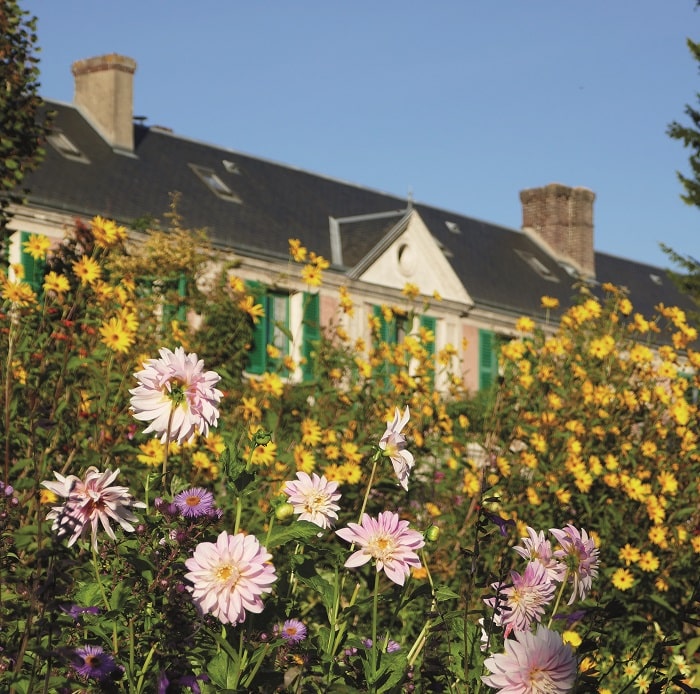
Monet’s house and gardens at Giverny © Opus Gothique
Monet’s Garden
In the 1800s, embracing Impressionism was a luxurious indulgence, one that represented creative rebellion. Before it took off, artists had mainly relied on the wealthy to commission them – most often, key figures in the church, who were interested solely in religious imagery or self-portraits.
Impressionism was a way for artists like Monet to reclaim freedom of expression and display what inspired them personally, rather than re-enacting someone else’s visions. The lack of funding behind it meant Impressionism didn’t fully find fame until after those we know now as the driving forces behind the movement, in the towns and villages near Paris, were already long gone.
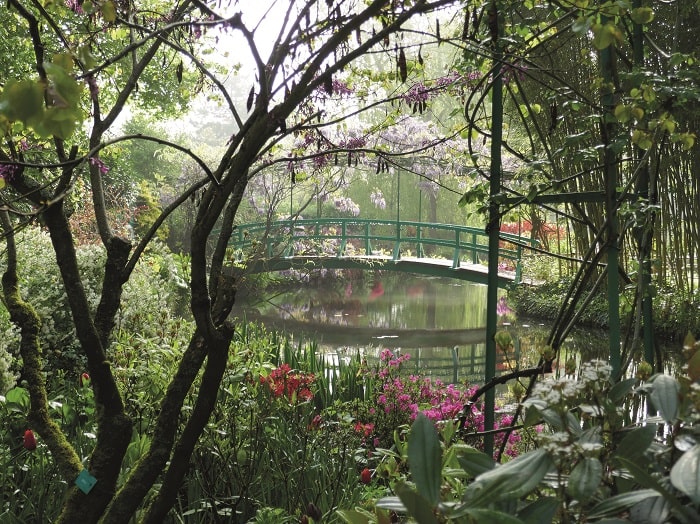
Monet’s gardens at Giverny inspired his ‘Water Lillies’ paintings © Maison et jardins de Claude Monet Giverny
Yet today it is celebrated in Giverny via the Claude Monet Foundation, which allows visitors to step inside his former home and enjoy the gardens that inspired his work, from the lily pads to the famous Japanese bridge framed by colourful flowers.
Though Monet had lived in Algiers, Marrakech and London, it was Giverny that fuelled his artistic imagination the most, with hundreds of his paintings honouring its beauty. There’s also a museum of Impressionism located in the town and it’s highly recommended to stop off in nearby Vernon and admire local landmarks, such as the restored medieval water mill, as seen in Monet’s painting ‘Houses On The Old Bridge At Vernon’.
Champagne Trail
Other beauty spots include the Cliffs of Étretat, which have their own stories attached to them. In one of Maurice LeBlanc’s legendary crime novels, The Hollow Needle, ‘gentleman thief’ Arsène Lupin steals art treasures from the likes of the Louvre, replaces them with worthless replicas and stashes the real items secretly in a hidden location – could it be within the needle-shaped rock formation of Étretat’s white chalk cliffs? The Lupin stories have now been adapted and transformed into a well-received Netflix series too.
The Champagne region is another popular spot for day-trippers, with Reims reachable within an hour by train from Paris. One of the most rewarding attractions here is a visit to Moët et Chandon’s network of underground cellars, with an obligatory tasting session of the best vintages afterwards. Plus one of the less obvious destinations, but especially rewarding, is Meaux, where visitors can discover a museum dedicated to the softest and creamiest Brie.
If you thought the best art treasures of France were confined solely to the likes of the Louvre and Musée d’Orsay, or if you thought the best food was limited to the capital’s restaurants, think again – there’s a huge host of trips tantalisingly close to Paris and they’ll take up many days of pleasurable exploration. Enjoy!
From France Today Magazine
Share to: Facebook Twitter LinkedIn Email
More in Day trips, Paris, Paris day trips, paris travel
By Chloe Govan
Leave a reply
Your email address will not be published. Required fields are marked *




REPLY